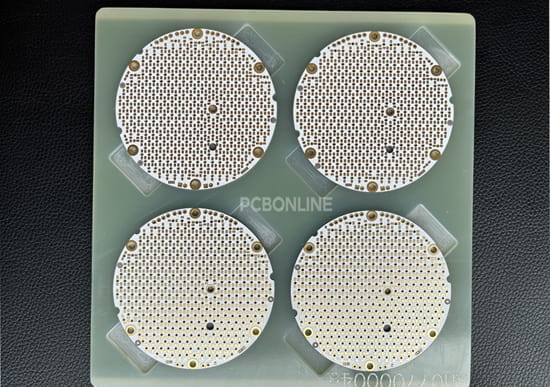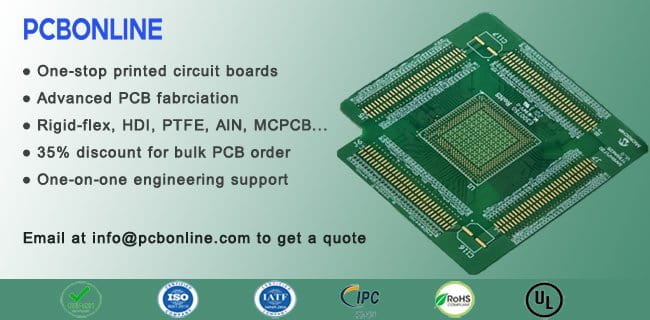PCB surface finish is a metal or organic coating on PCB pads that protects the copper and boosts solderability. Lead-free HASL (hot air solder leveling) is the most common PCB surface finish, and if you don't specify which surface finish you want, we assume you want lead-free HASL for your boards.
However, lead-free HASL is not allowed for flexible PCBs and rigid PCBs with a thickness smaller than 0.5mm. You have to replace it with ENIG (electroless nickel immersion gold) or OSP (organic solderability preservatives). This article reveals HASL and ENIG and compares them.
Part 1: HASL and Lead-Free HASL
HASL means using tin/lead solder to spray the PCB pads and then using hot air to blow the PCB surface so that the pad surface is level. The thickness of HASL is 1mil to 2mil (25.4μm to 50.8μm, or 0.025mm to 0.05mm).
HASL is a cheap PCB surface finish. And its solderability is good.
However, HASL doesn't meet the lead-free requirements in most of the world, and in most cases, we use lead-free HASL.
![]()
The properties of lead-free HASL are pure tin. The thickness of lead-free HASL is 0.1mil to 1mil (2.54μm to 25.4μm, or 0.0025mm to 0.025mm).
Lead-free HASL is the default surface finish from the PCB manufacturer PCBONLINE. Compared with HASL, PCB pads with lead-free HASL look dim, and the soldering temperatures are higher.
|
HASL
|
Lead-free HASL
|
|
|
Properties
|
Tin and lead (37% of lead)
|
Tin (lead less than 0.5%)
|
|
PCB pad finish
|
Glossy
|
Dim
|
|
Solderability
|
Good
|
A little worse than HASL
|
|
Reflow soldering temperatures
|
210℃ to 245℃
|
240℃ to 270℃
|
|
Wave soldering temperatures
|
About 250℃
|
About 260℃
|
Though lead-free HASL is common, it can't be applied to rigid PCBs with a thickness smaller than 0.5mm and flexible PCBs, neither HASL. These boards can't bear the spraying force. If you spray tin on these boards, they bend, and only the middle of the boards is sprayed with tin. Sometimes, rigid PCBs with a thickness smaller than 0.5mm may even break if you apply HASL or lead-free HASL to them.
In such cases, you can choose the other PCB surface finish -- ENIG. Or you can also change lead-free HASL to OSP. But OSP is easy to oxide. If you don't solder the PCBs at once, OSP oxides. And the manufacturer has to seal and package the OSP PCBs at once.
Part 2: What is ENIG

ENIG, also known as immersion gold, or chemical Ni/Au, is one of the best PCB surface finishes for almost all PCBs. In any case, if HASL or lead-free HASL can be used, you can replace it with ENIG. But inversely, HASL or lead-free HASL can't replace ENIG.
ENIG means plating a nickel alloy coating on the PCB pads and then a gold coating with chemical reactions. Besides PCB pads, ENIG can also be applied to other areas, such as the PCB edges or wires for thermal dissipation purposes. The thickness of ENIG is 1μm, 2μm, and 3μm. (From the equation 1mil=25.4μm, you can understand how thin the PCB finish ENIG is compared to HASL.)
ENIG PCB pads have a gold color and look shiny. Besides, the solderability of ENIG is the best among all the PCB surface finishes. And because gold has a dense crystal structure and is hard oxide, the protection of ENIG to copper of the PCB pads is also excellent.
Part 3: ENIG vs HASL vs Lead-Free HASL
ENIG PCBs are high-standard PCBs and they are usually used for high-end applications. As we mentioned above, ENIG can take the place of HASL and lead-free HASL in any case if your budget allows, but HASL and lead-free HASL can't replace ENIG.
Below is a comparison between EENIG and HASL.
|
|
ENIG
|
HASL
|
Lead-free HASL
|
|
Meeting lead-free requirements or not
|
Yes
|
No
|
Yes
|
|
Price
|
High
|
Low
|
Middle
|
|
Thickness
|
1μm, 2μm, and 3μm
|
25.4μm to 50.8μm
|
2.54μm to 25.4μm
|
|
Finish method
|
Chemical reactions
|
Spraying
|
Spraying
|
|
Properties
|
Nickel and gold
|
Tin and lead
|
Tin
|
|
Applications
|
Can be used for almost all PCBs
|
Simple FR4 PCBs with a thickness larger than 0.5mm
|
Common rigid PCBs with a thickness larger than 0.5mm
|
Part 4: One-Stop PCB Manufacturer Hassle-Free
PCBONLINE is a one-stop advanced PCB manufacturer founded in 1999, with two large advanced PCB manufacturing bases and one assembly factory. If you have needs for PCB and PCBA fabrication, PCBONLINE can be your reliable PCB/PCBA supplier from prototypes to bulk production.

In PCB surface finishes, PCBONLINE has these advantages:
- PCBONLINE can fabricate surface finishes including lead-free HASL, ENIG, hard gold plating, immersion silver, OSP, carbon ink, immersion tin, and palladium plating.
- We can achieve selective PCB surface finishes on your PCBs without a limit.
- Our engineers do free DFM (design for manufacturing) and you can stay hassle-free for your project.
- We manufacture flexible PCBs, rigid-flex PCBs, high-frequency PCBs, FR4 PCBs, HDI PCBs, AlN PCBs, alumina PCBs, aluminum PCBs, copper-base PCBs, and glass PCBs.
- We not only fabricate and assemble PCBs but also source electronic components for PCB assembly and assemble the PCBA to be box-built.
- One-on-one design and engineering support throughout your project.
- Free sample and functional jig testing for bulk production.
If you need PCB design, fabrication, assembly, and box build assembly, please feel free to contact PCBONLINE by email at info@pcbonline.com.
Conclusion
This article gives an introduction to HASL and ENIG separately and compares them. ENIG is universal for PCBs, especially for high-reliability PCBs. HASL doesn't meet the lead-free requirements but lead-free HASL does. If you don't know whether HASL can be used for your PCB or not, ENIG must be okay. You can also contact PCBONLINE for suggestions.
© This article is an original work of the PCBONLINE team. Please indicate the author PCBONLINE if you reprint. If the article is reproduced without permission or indicating the author's source, PCBONLINE reserves the right to investigate the infringement.




